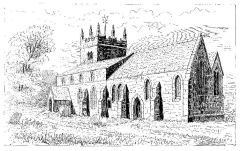| The known practice of religion in Colton goes back to Saxon times when the Domesday book records that Colton had a priest: apparently one of the few villages in Staffordshire to have one.The present Parish church shows evidence of being built in the 12th. century. It has been much altered through subsequent centuries culminating in a massive Victorian Restoration when it was almost totally rebuilt under the guidance of the Victorian architect, Street.In the 17th. century records show that some Colton residents were persecuted for practicing their Catholic faith when it was outlawed in this country. In the 19th. Colton had a small Methodist chapel now sadly gone. The Parish Church of St. Mary History of the church from documentary evidence Colton’s Involvement in the 17th. Century Popish Plot ‘A plot to kill the king!’ Methodism in Colton An account of the Methodist in Colton. Colton records of births, deaths and marriages Records going back to the 17th. Century. Parish Database |
The Parish Church of St. Mary There was a priest in Colton in Saxon times and the present Parish Church dates back to the 12th. Century. We have lots of documentary evidence about the church through the ages from our well preserved records. |
The Parish church of St. Mary, Colton St Mary in the snow. |
Colton Parish church is dedicated to St. Mary and has its foundations way back in the early12th. Century. Most of the present day church is a Victorian rebuild carried out in the 1860’s under the supervision of the well known Victorian architect Street. However the Tower, the south aisle wall attached to the Tower and the area used for the present day vestry, these are all remnants from the church built in the early 12th. Century.There is a priest recorded at Colton in the Domesday book who must have been there in Saxon times. Where the Saxon church was if indeed there was one, we have no idea for certain. However, in the 19th. Century when the ground in front of Bellamour Lodge in the region marked on many old maps as being the site of an old chapel (now extant) was being dug , a number of skeletons were unearthed. Whether this was the site of the original Saxon church or at least the burial ground is a matter of conjecture.Over the centuries there were a number of alterations to the church usually due to its state of deterioration However it underwent major renovations under Street. Whilst this was being done some of the original pre reformation wall paintings were discovered close to the small door in the south aisle. They were covered over but fortunately not before sketches were made of them which we still have a copy of. For a longer article about the building please go to the Buildings page of our web site. |
The Popish Plot
With the establishment of the Protestant Church as the state religion of England and particularly after the plot against James I st. known as the Gunpowder Plot; to attempt to adhere to the Catholic faith in England became a very dangerous thing to do . Catholiscm was ostensibly driven underground and adherents practiced their faith in secret constantly in fear of imprisonment and possible death.
When Walter Aston Lord of the manor of Colton had been ambassador to Spain for James I, he had converted to Catholiscm. Upon his return to Colton from Spain, the majority of the household and those who worked for him followed his lead and also became practicing Catholics as was the convention in those days. His son Herbert Aston who built and lived at Bellamour, also converted.
In 1678 an infamous character called Titus Oates began broadcasting to all and sundry that he knew of a new Catholic plot to kill the king- this time Charles II. His evidence came from the testimony of a man called Dugdale who had been an employee of Lord Stafford. He claimed that Lord Stafford was the prime plotter but was aided by others including Herbert Aston and that part of the plot had been hatched at Bellamour Hall. All the alleged plotters were arrested and imprisoned in the Tower of London.
 |
The ruins of Bellamour where the plot was supposedly partly hatched! Lord Stafford was tried and the evidence mainly of Dugdale, was enough to condemn him to death. This was was duly carried out. However, fortunately before Lord Aston was brought to trial, the allegations were revealed as a hoax and Lord Aston was released. What the whole episode illustrated was the fear England had in the late 17th and all through the 18th Century that the country would return to Catholiscm as the religion of the State. |
The Methodists in Colton
Methodism reached Colton as it did many towns and villages, in the 19th Century. With the onset of the Industrial Revolution the established church of England lost its appeal to the working classes whereas Methodism and the other Free Church denominations preached a message that appeared to be a lot more relevant to them.
A small Wesleyan chapel was established in Colton half way along the high street of the village paid for by a Rugeley benefactor- Elizabeth Birch. It was only open for a few years. A number of the villagers worshipped there.
It closed its doors at the end of the 19th. Century and was converted into a private house.
Colton records of Births, Deaths and Marriages
We are very fortunate to have our records preserved fairly intact from the 17th century onwards.
Parish Database
The Parish database currently consists of Baptism, Marriage and Burial records for St Mary’s Church Colton.